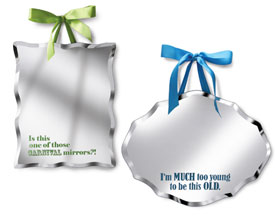In her book The Body Project: An Intimate History of American Girls, Joan Jacobs Brumberg argues that increased access to mirrors in the 1800s helped spur middle-class Victorian obsessions with the body, particularly skin and the presence of acne on the face. Mirrors gave the average person more of an ability to imagine themselves through others’ eyes and to inspect every part of their body (and presumably find it lacking).
Samantha J. showed me the logical end-point of this association between mirrors and negative appraisals of one’s body: mirrors that don’t make you do the work of negatively judging your body, but just go ahead and do it for you.
The one on the left says, “Is this one of those CARNIVAL mirrors?!” and the one on the right says, “I’m MUCH too young to be this OLD” (found here). The mirror below (found here) says, “Are you really gonna wear that?”
Of course, if you want a self-esteem boost, or already feel really good about yourself, you could buy this one (found with the one above), which says, “I’m the fairest of them all…”:
Anyway, they might provide a (sort of silly) illustration to go with a discussion of how increased access to mirrors or other technologies (is a mirror a technology?) have affected perceptions of the body and our ability to scrutinize every inch of it (which could, of course, be part of a larger discussion about how changes in technology can affect cultural trends).
Thanks, Samantha J.!




Comments 6
Elena — November 3, 2008
Glass mirrors beat bronze mirrors any day of the week, but they've been around for a long, long time.
Maddy — November 3, 2008
I made my own mirror that says "I am beautiful" across the top. I thought it was a nice balance between "I'm hideous" and "I'm the hottest shit ever."
Gwen Sharp, PhD — November 3, 2008
Wow--those bronze mirrors don't look very, um, reflective.
Brumberg's argument is just that in the late 1800s, rising incomes and the ability to manufacture glass mirrors made them more easily available to a wider part of the population...and in larger sizes, so people could see larger portions of their bodies at once.
Elena — November 4, 2008
The museums usually highlight the decorated backs of mirrors, but the other side is supposed to be a plain sheet of polished metal -- bronze, tin or silver for the well-off. The image isn't particularly good, and you still were supposed to polish it regularly to avoid oxidation.
They were also so small that you seldom could see your full face in them...
Florine — November 8, 2008
There's a Dutch design mirror by Joop Steenkamer that does the opposite: it tells you Oh, wat ben je mooi (Oh, you're so beautiful).
There is an English version but I couldn't find a picture.
Miriam Heddy — November 10, 2008
On a related note, the "I'm the fairest one of all" takes the line from Snow White and applies it more broadly to anyone who looks in it.
Yet fair skin (rather than the other meaning of fairness) is the ideal, and to be "the Fairest" is to be the object of envy.